- Clone
- 1B11 (See other available formats)
- Regulatory Status
- RUO
- Other Names
- Ly-48, Leukosialin, Sialophorin, Leukocyte Sialoglycoprotein, gp115
- Isotype
- Rat IgG2a, κ
- Barcode Sequence
- AGAAACCGCCCTCAT
| Cat # | Size | Price | Quantity Check Availability | ||
|---|---|---|---|---|---|
| 121229 | 10 µg | $369.00 | |||
CD43, also known as Ly-48, Leukosialin, Sialophorin, Leukocyte Sialoglycoprotein, and gp115, is a large single chain of type I transmembrane glycoprotein with abundant O-glycosylation and sialylation sites. Due to variable glycosylation and sialylation, two isoforms of CD43 have been identified. The 115 kD glycoform of CD43 is expressed on most hematopietic cells including T lymphocytes, NK cells, monocytes, granulocytes, platelets, and CD5+ B cells. It is not present on resting B cells and erythrocytes. While the 130 kD glycoform is thought to be activation-associated form primarily expressed on myeloid cells, pre-B cells, and activated T cells. It has been reported that CD43 binds to CD54 and Siglec-1. CD43 plays dual roles in cell adhesion and anti-adhesion, as well as costimulation of T cell activation and survival, and induction of apoptosis of T cells and hematopoietic progenitors. The 1B11 antibody reacts with the activation-associated glycoform of CD43. The epitope recognized by 1B11 is also shared with desialylated CD45RB. This antibody is useful for differentiation of effector CD8 T cells and memory T cells.
Product Details
- Verified Reactivity
- Mouse
- Antibody Type
- Monoclonal
- Host Species
- Rat
- Immunogen
- Mouse WEHI 274.3 myeloid tumor cells
- Formulation
- Phosphate-buffered solution, pH 7.2, containing 0.09% sodium azide and EDTA
- Preparation
- The antibody was purified by chromatography and conjugated with TotalSeq™-C oligomer under optimal conditions.
- Concentration
- 0.5 mg/mL
- Storage & Handling
- The antibody solution should be stored undiluted between 2°C and 8°C. Do not freeze.
- Application
-
PG - Quality tested
- Recommended Usage
-
Each lot of this antibody is quality control tested by immunofluorescent staining with flow cytometric analysis and the oligomer sequence is confirmed by sequencing. TotalSeq™-C antibodies are compatible with 10x Genomics Chromium Single Cell Immune Profiling Solution.
To maximize performance, it is strongly recommended that the reagent be titrated for each application, and that you centrifuge the antibody dilution before adding to the cells at 14,000xg at 2 - 8°C for 10 minutes. Carefully pipette out the liquid avoiding the bottom of the tube and add to the cell suspension. For Proteogenomics analysis, the suggested starting amount of this reagent for titration is ≤ 1.0 µg per million cells in 100 µL volume. Refer to the corresponding TotalSeq™ protocol for specific staining instructions.
Buyer is solely responsible for determining whether Buyer has all intellectual property rights that are necessary for Buyer's intended uses of the BioLegend TotalSeq™ products. For example, for any technology platform Buyer uses with TotalSeq™, it is Buyer's sole responsibility to determine whether it has all necessary third party intellectual property rights to use that platform and TotalSeq™ with that platform. - Application Notes
-
Additional reported applications (for the relevant formats) include: immunoprecipitation1,2, Western blotting1,2, and immunohistochemistry of acetone-fixed frozen sections.
- Additional Product Notes
-
TotalSeq™ reagents are designed to profile protein levels at a single cell level following an optimized protocol similar to the CITE-seq workflow. A compatible single cell device (e.g. 10x Genomics Chromium System and Reagents) and sequencer (e.g. Illumina analyzers) are required. Please contact technical support for more information, or visit biolegend.com/totalseq.
The barcode flanking sequences are CGGAGATGTGTATAAGAGACAGNNNNNNNNNN (PCR handle), and NNNNNNNNNCCCATATAAGA*A*A (capture sequence). N represents either randomly selected A, C, G, or T, and * indicates a phosphorothioated bond, to prevent nuclease degradation.
View more applications data for this product in our Scientific Poster Library. -
Application References
(PubMed link indicates BioLegend citation) -
- Jones AT, et al. 1994. J. Immunol. 153:3426. (IP, WB)
- Carlow DA, et al. 1999. J. Immunol. 163:1441. (IP, WB)
- Onami TM, et al. 2002. J. Immunol. 168:6022.
- van der Most RG, et al. 2003. Intl. Immunol. 15:119.
- Chu VT, et al. 2007. J. Immunol. 179:5947.
- Lang A, et al. 2008. J. Immunol. 180:4848. PubMed
- Gibbert K, et al. 2010. J. Immunol. 185:6179. PubMed
- RRID
-
AB_3662419 (BioLegend Cat. No. 121229)
Antigen Details
- Structure
- Single chain of type I transmembrane glycoprotein with abundant O-glycosylation and sialylation sites, 115 kD and 130 kD glycoforms with different glycosylation and sialylation
- Distribution
-
Most hematopoietic cells including peripheral T cells, NK cells, granulocytes, monocytes, thymocytes, platelets, plasma cells, CD5+ B-1 cells and activated B cells, and hemotopoietic progenitor cells.
- Function
- Play a dual roles in cell-cell adhesion and anti-adhesion, costimulation of cell activation and survival, induce apoptosis of T cells and hematopoietic progenitors
- Ligand/Receptor
- CD54, Siglec-1
- Cell Type
- B cells, Granulocytes, Hematopoietic stem and progenitors, Monocytes, NK cells, Plasma cells, Platelets, T cells, Thymocytes
- Biology Area
- Immunology
- Molecular Family
- Adhesion Molecules, CD Molecules
- Antigen References
-
1. van den Berg TK, et al. 2001. J. Immunol. 166:3637.
2. Moore T, et al. 1994. J. Immunol. 153:4978.
3. Onami TM, et al. 2002. J. Immunol. 168:6022.
4. Tong J, et al. 2004. J. Exp. Med. 199:1277.
5. Jones AT, et al. 1994. J. Immunol. 153:3426. - Gene ID
- 20737 View all products for this Gene ID
- UniProt
- View information about CD43 on UniProt.org
Other Formats
View All CD43 Reagents Request Custom ConjugationCompare Data Across All Formats
This data display is provided for general comparisons between formats.
Your actual data may vary due to variations in samples, target cells, instruments and their settings, staining conditions, and other factors.
If you need assistance with selecting the best format contact our expert technical support team.
-
Purified anti-mouse CD43 Activation-Associated Glycoform

C57BL/6 mouse splenocytes stained with purified 1B11, follow... -
Biotin anti-mouse CD43 Activation-Associated Glycoform
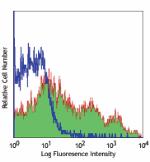
C57BL/6 mouse splenocytes stained with biotinylated 1B11, fo... -
FITC anti-mouse CD43 Activation-Associated Glycoform
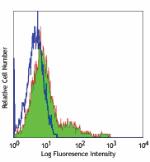
C57BL/6 mouse splenocytes stained with 1B11 FITC -
PE anti-mouse CD43 Activation-Associated Glycoform

C57BL/6 mouse splenocytes stained with 1B11 PE -
Alexa Fluor® 488 anti-mouse CD43 Activation-Associated Glycoform
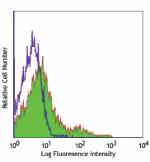
C57BL/6 mouse splenocytes stained with 1B11 Alexa Fluor® 488 -
Alexa Fluor® 647 anti-mouse CD43 Activation-Associated Glycoform

C57BL/6 mouse splenocytes stained with 1B11 Alexa Fluor® 647 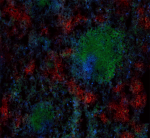
3 Day 4T1 cells induced BALB/c frozen spleen section was fix... -
APC anti-mouse CD43 Activation-Associated Glycoform
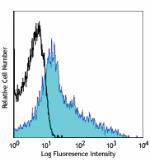
C57BL/6 mouse splenocytes stained with 1B11 APC -
PE/Cyanine5 anti-mouse CD43 Activation-Associated Glycoform

C57BL/6 mouse splenocyts stained with 1B11 PE/Cyanine5 -
PE/Cyanine7 anti-mouse CD43 Activation-Associated Glycoform

C57BL/6 mouse splenocytes stained with 1B11 PE/Cyanine7 -
APC/Cyanine7 anti-mouse CD43 Activation-Associated Glycoform
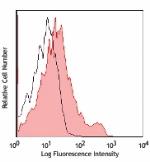
C57BL/6 mouse splenocytes stained with 1B11 APC/Cyanine7 -
PerCP anti-mouse CD43 Activation-Associated Glycoform
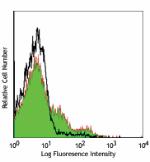
Balb/c mouse splenocytes stained with 1B11 PerCP -
PerCP/Cyanine5.5 anti-mouse CD43 Activation-Associated Glycoform
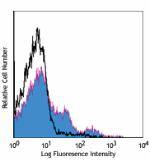
Balb/c mouse splenocytes stained with 1B11 PerCP/Cyanine5.5 -
PE/Dazzle™ 594 anti-mouse CD43 Activation-Associated Glycoform
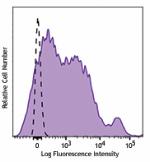
C57BL/6 mouse splenocytes stained with CD43 (clone 1B11) PE/... -
TotalSeq™-B1284 anti-MU CD43 Activation-Associated Glycoform
-
TotalSeq™-C1284 anti-MU CD43 Activation-Associated Glycoform
